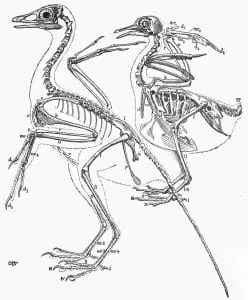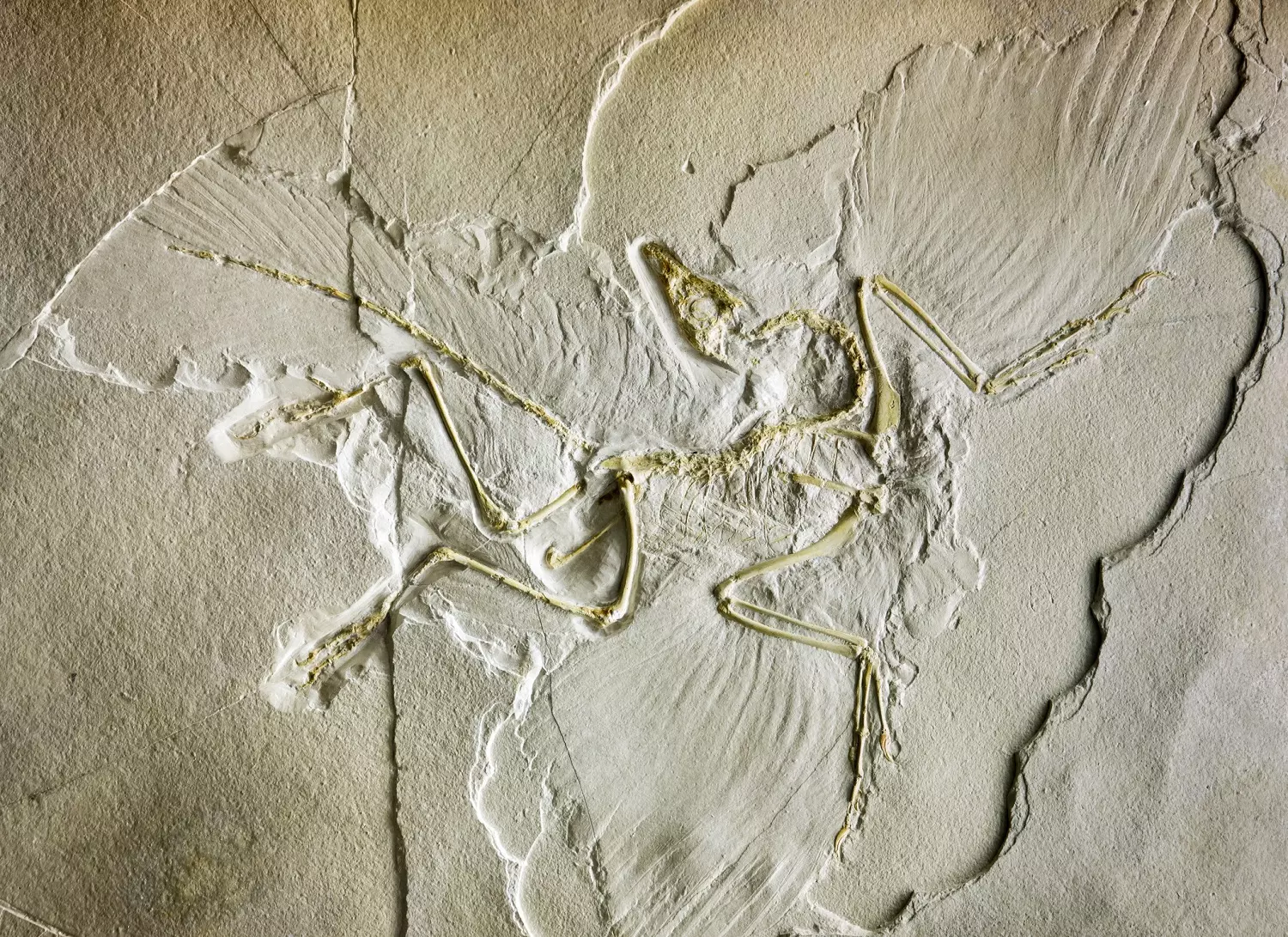[Originally published by Christian Ryan as Archaeopteryx: Just a Weird Perching Bird?]
Scientists were in for a surprise when the fossilized skeleton of an unusual creature was discovered in 1861 at Bavarian, Germany’s Solnhofen Limestone. This site is famous for its exquisitely preserved fossils. This creature had the feathers of a bird, but it also had the clawed forelimbs, toothed jaw, and long, bony tail of a theropod (meat-eating) dinosaur. In 1863, Sir Richard Owen described it under the name Archaeopteryx, meaning “ancient wing.”
But to what group of animals did Archaeopteryx belong?
Since birds are the only animals that have feathers today, Owen considered this creature to be an unusual type of bird.1 Most creationists have followed suit, arguing that Archaeopteryx is nothing more than an odd perching bird.2 But what kind of bird has a long, bony tail?
Let’s Get to Know the Ancient Wing
Archaeopteryx is unique because its perfectly preserved remains allow us to know much more about it than most extinct animals. It was about the size of an American crow and was a carnivore, hunting for animals smaller than itself.
Archaeopteryx also had an enlarged, retractable claw on its second toe, similar to that seen in velociraptor. Comparisons of its sclerotic (eye) bones to those of other birds and reptiles indicate that Archaeopteryx would have been active primarily during the day.3 Its feathers are so well-preserved that scientists can study the pigment-producing cells. These studies suggest that Archaeopteryx was at least partially black in color.4
As mentioned above, Archaeopteryx had a blend of reptilian and bird features. Its more “bird-like” characteristics include:
- Feathers
- Brain structure
- Inner ear
- Air sacs
Whereas its decidedly more “reptilian-like” characteristics include:
- Toothed jaw
- Long, bony tail
- Gastralia (“belly ribs”)
- Clawed forelimbs
It was once thought that Archaeopteryx had a reversed toe that would have allowed it to perch on branches like many birds today. Better preserved specimens revealed this not to be the case.5
Is Archaeopteryx Just a Bird?
The problem with assuming that Archaeopteryx was “just an unusual bird” is that it shares many features with animals that most would regard as not being birds. Majungasaurus, for example, was a mid-sized, featherless theropod. Yet, it had air sacs, much like modern birds do.6 Instead of trying to classify every animal with feathers as a bird, we ought to reconsider how we define the word “bird.”
What Exactly is a Bird Anyway?

Zoologist Dr. Marc Surtees has recently developed a set of new criteria to distinguish birds from non-birds:7
- A sophisticated flow-through lung connected to air sacs
- Lightweight, air-filled bones
- A robust wing attachment site consisting of the wishbone, shoulder blade, and coracoid (a type of shoulder bone)
- A hook-like extension of the coracoid called the acrocoracoid
- Pygostyle (rod-like or blade-like bone at the end of the tail)
- Brain with enlarged cerebellum and visual cortex
Dr. Surtees states that while some animals may have some of the features listed above, true birds should possess all of them. For example, despite having a sophisticated flow-through lung connected to air sacs, Majungasaurus was not a bird because it lacked many of the above traits. Based on these criteria, now-extinct toothed birds like Hesperornis and Ichthyornis, and of course, modern birds, can be officially classified as “true birds.”
Interestingly, Archaeopteryx is missing many of these criteria, including a pygostyle. This means that, based on these criteria, it is actually not a bird at all. This makes sense in light of recent research by creation paleontologists. While Archaeopteryx has proven difficult to classify, several analyses have placed it as a close relative of small, feathered dinosaurs like Velociraptor and the troodontids.8,9 This suggests that Archaeopteryx was, in fact, not a true bird at all.
Conclusion
We often charge our old earth colleagues with allowing their biases to cloud their interpretation of the data. But the reality is that we all have biases that may cloud the proper interpretation of scientific data. As far as Archaeopteryx is concerned, we have often been guided by the extra-biblical assumption that birds can be the only thing with feathers. This has made a mess of bird/dinosaur classification schemes.
There is no way to completely remove the existence of our biases. But we must always be willing to change our minds on a certain issue when either biblical or scientific data does not fit our initial perception. Archaeopteryx has taught us that God’s creation is still full of many wonderful (and feathered) mysteries left to solve.







Three thoughts concerning the feathered dinosaur idea. 1. Since we are made in the image of God, we have the innate ability to organize, classify and name things. Biblically I Cor 15:39 indicates that there are 4 broad categories with different flesh: man, beast, fish and birds. Today only birds have feathers, why would we assume it was different in the past?
2. Only 11 or 12 archaeopteryx’s fossils have ever been found and they all came from the same limestone pit in Germany. The first one was discovered only 2 years after Darwin’s book was published – that just smells of fraud and there are many scholarly articles which agree
3. It is used today as the link between reptiles and birds. We need to be very careful not to support something they may lead others away from the truth.
While aspects of archaeopteryx’s discovery seem suspicious, the evidence is circumstantial. Being buried together merely means they died together. Analyses have revealed many details, such as quill knobs where ligaments connected to the feathers, that would not have existed if the fossils had simply been altered (Sarfati). Years of study and scientific advances have yet to disproven its authenticity (unlike every single suggested ape ancestor to date), and have instead further proven to evolutionists that it is not the protobird they search for. Furthermore, I would like to note that some other toothed-birds that evolutionists are considering to replace archaeopteryx as the protobird, mainly Epidexipteryx, are found at other locations and look very similar. I feel they are potentially just different varieties of the same animal, just as differences exist within Canidae and Ceratopsia.
Also, the Biblical category “birds” tends to be more accurately translated as “flying animals”. In Deuteronomy 14:11-12, Moses includes bats, carnivorous birds & ostriches in the list of unclean “birds”. Genesis 1 uses an even more general Hebrew word for “birds” (“oph” instead of “tsippor”), which includes flying insects (“Deuteronomy 14:11-18 meaning”; “Bible Dictionaries”). This usage of “bird” is clearly not only based on feathers. Though I do not know if it was ever mentioned, people throughout history probably grappled just as much with whether or not ostriches were true birds.
That being said, I agree with you that archaeopteryx’s strong physical similarities to birds means it should be placed within that group (see my main comment for more details).
Works Cited:
“Bible Dictionaries: Birds.” Holman Bible Dictionary, Broadman & Holman, 1991, Edited by Trent C. Butler,
StudyLight.org, http://www.studylight.org/dictionaries/eng/hbd/b/birds.html. Accessed 1 June 2024.
“Deuteronomy 14:11-18 meaning.” The Bible Says, 2024, https://thebiblesays.com/commentary/deut/
deut-14/deuteronomy-1411-18/. Accessed 1 June 2024.
Sarfati, Jonathan. “Archaeopteryx (unlike Archaeoraptor) is NOT a hoax – it is a true bird, not a ‘missing link’.”
Creation.com | Creation Ministries International, CMI-Australia, 24 March 2000, https://creation.com/
archaeopteryx-unlike-archaeoraptor-is-not-a-hoax-it-is-a-true-bird-not-a-missing-link. Accessed 1 June 2024.
Clarification: I was referring to the authenticity of actual half-human-half-ape ancestors, not the remains of apes or humans that were just mislabeled (there is still scientific evidence they are not missing links, but they are still authentic finds).
I apologize that this part of my previous post was a bit vague.
While I agree with Carla Estell on being wary of reclassifying archaeopteryx as something other than a bird, it is important to mention a few things.
God did give us the innate urge to classify/name things, and actually wants us to do so. In Genesis 2, God “brought” the animals to Adam for this very purpose (KJV). However, that does not mean doing so is always easy. This article is not surprising. Since the species was discovered, emerging data has caused archaeopteryx to be constantly flip-flopped by evolutionists and creationists alike between being classified as a bird, reptile… or neither.
The platypus, which lays eggs and has a beak, had the same problem until a special new category – monotremes – was finally added to Mammalia so it could be included in that class. On the same note, I have to disagree strongly with the authors of this article. I feel the solution is to place archaeopteryx in its own taxonomic order within the bird class, not remove it completely. Ignoring which class an animal is most similar to based on extremely minor physical differences, such as lack of a pygostyle, seems a bit drastic.
Furthermore, accepting the reclassification suggested by Dr. Surtees seems to go against current data, which shows archaeopteryx and other feathered theropods being less similar to dinosaurs than previously thought. Even some of the article’s sources point in the same direction: “Either implicitly or explicitly, these studies have linked anatomical, physiological or behavioural inferences with an increased metabolic potential, suggesting that if not bird-like in metabolism, theropods were at least ‘more similar’ to birds than to reptiles” (O’Connor). Expanding the bird class would make room for any bird-like creatures mislabelled as dinosaurs. I would also like to note that modern birds still have a deactivated gene for teeth that is connected to other mutations as well, including in the limbs (Sire; Wieland). Although lethal in the experiment, a genetic linkage between teeth in birds and skeletal differences associated with creatures like archaeopteryx is possible; unfortunately, the genes for teeth are simply not all there anymore for us to check for sure.
As the article states, we all have to be careful not to let our biases interfere with following the data. However, we have to be equally careful not to quickly accept new suggestions to science without fully testing them. That is how the idea of evolution was able to spread in the first place. Instead, changes in scientific ideas should spark both curiosity and caution, especially when the topic is controversial. Sometimes this means that we simply have to be patient for more data before making final conclusions. But that is part of what makes life interesting.
Works Cited:
AFP and AG Staff. “Archaeopteryx knocked off evolutionary perch.” Australian Geographic, 28
July 2011, https://www.australiangeographic.com.au/news/2011/07/archaeopteryx-
knocked-off-evolutionary-perch/?utm_source=pocket_reader. Accessed 1 June 2024.
O’Connor, Patrick & Claessens, Leon. “Basic avian pulmonary design and flow-through
ventilation in non-avian theropod dinosaurs.” Nature, 14 July 2005, vol. 436, pg. 253-6,
doi: 10.1038/nature03716. Accessed 1 June 2024.
Sarfati, Jonathan. “Archaeopteryx (unlike Archaeoraptor) is NOT a hoax – it is a true bird, not a
‘missing link’.” Creation.com | Creation Ministries International, CMI-Australia, 24
March 2000, https://creation.com/archaeopteryx-unlike-archaeoraptor-is-not-a-hoax-it-is-
a-true-bird-not-a-missing-link. Accessed 1 June 2024.
Sire, Jean-Yves et al. “Hen’s teeth with enamel cap: from dream to impossibility.” BMC
Evolutionary Biology, vol. 8, no. 246, 5 September 2008, doi:10.1186/1471-2148-8-246.
Accessed 1 June 2024.
Wieland, Carl. “Chickens with teeth.” Creation.com | Creation Ministries International, 25 July
2006, https://creation.com/chickens-with-teeth. Accessed 15 May 2024.